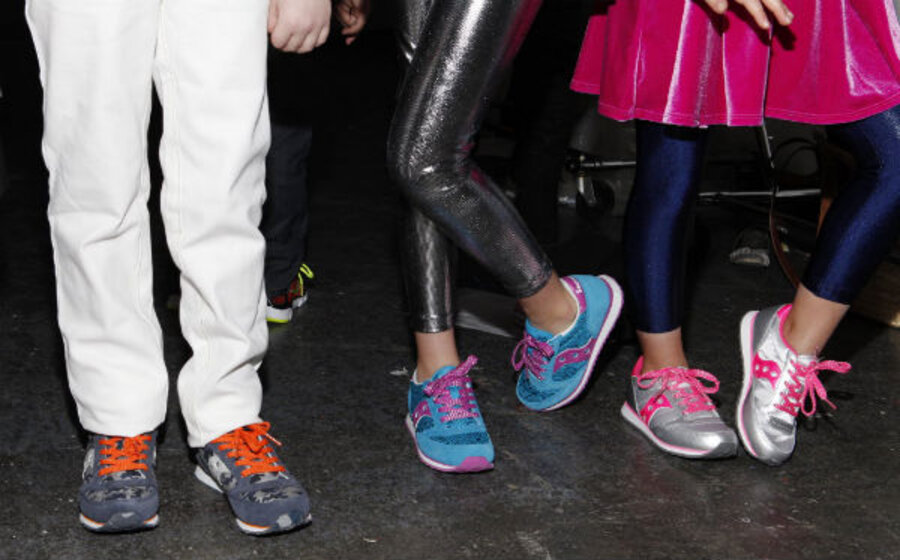Stride Rite: Shoes that peddle gender stereotypes
Loading...
Last April, I posted about how Stride Rite positions girls as pretty and boys as active. After seeing their in-store advertisements and reviewing their product descriptions online, I concluded that according to Stride Rite, girls are meant to be looked at, so their play shoes are a route to prettiness, while boys are meant to be active, so their play shoes are made for play.
Last week, while doing some back-to-school shopping with her young daughters, Margot Magowan of Reel Girl encountered similar advertising at her local Stride Rite store in San Francisco. She was deeply disappointed in how the brand perpetuated the idea that girls are dramatically different from boys–sparkling princesses versus powerful fighters. And she linked back to my post from last year to offer context, showing that Stride Rite’s hyper-gendered marketing is business as usual for the brand.
Her blog post about it struck quite the chord: The Daily Mail, the Huffington Post, and Jezebel all picked up the story, quoting Margot and myself on the topic. Margot also was interviewed by Fox and Friends.
As Margot put it on Fox and Friends: “Feet are not that different. Boys and girls, especially four-year-olds, have basically the same shoes and basically the same feet.” So why such a strong and stereotypical gender segregation?
The Daily Mail connected Stride Rite’s marketing to broader trends; for example, they cited research by Elizabeth Sweet, a doctoral candidate in sociology at the University of California, whose research suggests that gender segregating and stereotyping of toys is becoming worse with time–so much so that “the world of toys looks a lot more like 1952 than 2012.”
[The Christian Science Monitor editor's note: For it's part, Stride Rite responded to these concerns with the following statement, which focuses on their footwear but not their marketing strategies.
"Stride Rite Children’s Group develops footwear that is specifically designed to meet the needs of growing children while offering a broad assortment of products in a range of styles that are of interest for both girls and boys. We strongly believe that all kids should be active and we provide shoes that enable and encourage kids to play and use their imaginations. Our commitment to quality, style and “kid rite” innovation is at the forefront of our minds as we strive to provide options to all parents and children."]
Meanwhile, Jezebel offered a characteristically entertaining approach to the subject, writing:
This just in: being a child and taking steps to propel you from one area to another is a gendered act. Boys walk; girls sparkle and twirl and make princess wishes. Boys also crouch and pretend to shoot webs out of their hands, because that sort of thing is fun when you are a boy. (The only time that girls crouch is when they are picking up face-up pennies in their never ending quest to make a lot of wishes.)
On the other hand, the Huffington Post coverage offered a fairly straightforward summary of our blog posts, but the comment thread was often infuriating:
- Some commenters were defensive, arguing that there’s nothing wrong with being a girly-girl who likes princess products. This is true, but the argument misses the point: The problem is when girls are ONLY offered girly-girl/princess items. There are so many ways to be a girl, and marketing like Stride Rite’s reduces girls to ONE form of girlishness only.
- Other commenters defended corporations like Stride Rite and blamed parents for the gender stereotyping of childhood, claiming it is the parents’ job to raise their children properly. This, too, is true, but also misses the point: even the most devoted parents are hard-pressed to fight back against the billion-dollar marketing machine that is so invested in separating the boys from the girls. (After all, fostering a separation between the sexes is a great way to sell twice as many products.)
Inspired by that comment thread, Lori Day of the Huffington Post wrote a terrific piece about the media’s shameless peddling of gender stereotypes to children. She explains:
"A lot of adults are laughing all the way to the bank as our kids pass under the bus. The strategy is simple: convince kids of both genders that they are very different from each other and that they need completely different products with different colors and different labels, and they will naturally only want what they’ve been told is “for” them and what has been spoon fed to them since birth. Parents will then dole out double the money buying separate products for their sons and daughters, ensuring that the retailers and marketers double their profits and double down on the stereotyped messaging. And why wouldn’t they? It’s brilliant. It’s lucrative. It’s also a breathtaking act of psychological vandalism against our children. Media shapes perception, and perception becomes reality."
The Christian Science Monitor has assembled a diverse group of the best family and parenting bloggers out there. Our contributing and guest bloggers are not employed or directed by the Monitor, and the views expressed are the bloggers' own, as is responsibility for the content of their blogs. Rebecca Hains blogs at rebeccahains.wordpress.com.






